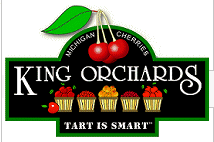home > all about cherries > cherry industry > page 3
Tart Cherry Industry - continued
Introduction
The red tart cherry, Prunus cerasus, is a perennial tree fruit
related to the plum, peach, apricot, almond, and numerous other
species of the north temperate zone. It is grown commercially for
its tart and juicy fruit, which is primarily used in baking and
cooking. Fully ripened tart cherries may be eaten raw, but are too
acid for many palates. The raw fruit stores poorly and its shelf
life is too short for the fresh-market trade.
Tart cherries are also known by other names. They are at times
called “sour cherries” due to their sour flavor. They are also
referred to as “pie cherries” because they are commonly used in
baking, or “red cherries” because of their bright red color.
Michigan produces 70-80 percent of the tart cherries grown in the
United States. Other states having commercial acreages include
Colorado, New York, Oregon, Pennsylvania, Utah, Washington, and
Wisconsin. The annual farm value of the U.S. tart cherry crop
averaged $44 million between 1985 and 1995. The value of the crop
was at a low of $19 million during the 1995 crop year, and at a peak
of $88 million in the 1991 crop year.
The Tart Cherry Tree -
Varieties
There are hundreds of named tart cherry cultivars. Only the
Montmorency cultivar, however, is of economic importance in the U.S.
currently. Montmorency originated in the Montmorency Valley of
France during the 17th century and was likely introduced into America
in the late 1700s or early 1800s. Its fruit is about three-fourths
of an inch in diameter and has a roundish-oblate (slightly
compressed) shape. Its skin color ranges from bright red when first
ripe to dark red when fully ripe. The flesh has a pale yellow color
with a reddish tinge, and the juice has a light pink color and a
sprightly flavor.
The Montmorency fruit ripens during July in most areas, with harvest
extending into August in the more northern regions. Montmorency’s
firm flesh and long harvest season make it wellsuited
for processing. Virtually all of the commercial U.S. acreage
is planted to the Montmorency variety.
Two Hungarian varieties are currently being produced on a trial basis
in several states. One of these, referred to in the Michigan area as
Balaton, reportedly "has the potential to be the first significant
new cultivar planted in the United States since the introduction of
Montmorency" (Nugent). Balaton blooms several days after
Montmorency, reducing the likelihood of crop failure due to a late
spring frost destroying the young fruit buds. Central Michigan
reportedly had only about one-third its normal Montmorency crop in
1996 because of freeze damage to the fruit buds on May 13. The
Balaton trees in that area, however, reportedly were loaded with
cherries as they bloomed later than the Montmorency cultivar,
escaping damage (Danilovich).
Like Montmorency, Balaton produces an abundant crop of firm fruit
which processes well. There remains a question, however, about its
market acceptance. Balaton’s flesh and juice have a red color,
whereas Montmorency has a light-colored flesh and juice. Unlike
Montmorency, whose fruit retains a bright red color when cooked,
Balaton fruit turns dark and may not be desired by U.S. consumers,
who are better acquainted with a bright red cherry.
Currently, there are only a handful of bearing-age Balaton trees in
the United States, but the acreage of this variety is expected to
increase. Nevertheless, Montmorency will continue being the dominant
variety for many years because the trees currently in the ground have
many years of prime fruit-bearing life remaining.
|




